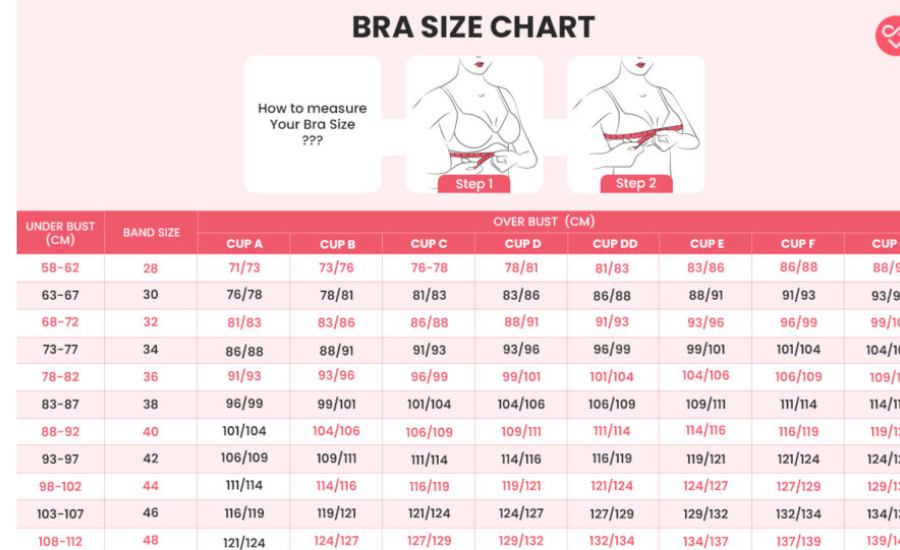Understanding Bra Sizes Guide
Bra sizes consist of a band size (number) and a cup size (letter), representing the measurement around the ribcage and the difference between the ribcage and bust size, respectively. Understanding these components is crucial for finding a comfortable and supportive bra that fits properly.
Importance of Sister Sizes
Sister sizes are an essential concept in bra fitting that can help women find a comfortable and well-fitting bra even when their exact size is unavailable. Sister sizes are bras with the same cup volume but different band sizes, allowing for flexibility in finding the right fit.
The principle behind sister sizing is that as the band size increases, the cup size decreases to maintain the same volume. For example, a 42G bra has the same cup volume as a 43F and a 36B. This relationship exists because cup size is relative to band size, not an absolute measurement.
Understanding sister sizes is crucial for several reasons:
- Accommodating body changes: Weight fluctuations, pregnancy, or hormonal changes can affect bra size. Sister sizing allows for adjustments without completely changing your bra size.
- Brand variations: Different brands may have slight variations in their sizing. Knowing your sister sizes can help you navigate these differences.
- Style differences: Some bra styles may fit differently even in the same size. Sister sizing allows you to adjust for these variations.
- Availability: If your exact size is out of stock, you can try a sister size for a similar fit.
To find your sister sizes:
- For a smaller band size: Go down one band size and up one cup size (e.g., 34C to 32D).
- For a larger band size: Go up one band size and down one cup size (e.g., 34C to 36B).
It’s important to note that while sister sizing can be helpful, it’s not always a perfect solution. The band provides most of the support in a bra, so changing band sizes significantly may affect the overall fit and support. Always prioritize a snug band fit when trying sister sizes.
Understanding sister sizes empowers women to make informed decisions when shopping for bras, potentially increasing their options and improving their chances of finding a comfortable, well-fitting bra.
Impact of Fabric Stretch
The stretch factor of bra fabrics plays a crucial role in achieving the perfect fit, particularly for the back band, which is typically the stretchiest part of the bra. Understanding how fabric stretch affects bra sizing and fit is essential for both bra manufacturers and wearers.
Fabric stretch directly impacts the negative ease required in bra design. Negative ease refers to the amount by which a garment is smaller than the body it’s meant to fit, allowing it to stretch and provide a snug fit. For bras, the more a fabric stretches, the shorter the band needs to be to provide adequate support.
To account for fabric stretch when adjusting bra patterns, some designers use a general rule of reducing length by 3% for every 10% of stretch in the fabric. For example, if a fabric has 75% stretch, the band length would be reduced by 22.5%. This adjustment ensures that the bra provides proper support and doesn’t become loose over time.
The evolution of bra materials has also impacted sizing methods. In the 1950s, bras were made from non-stretch fabrics like silk and satin, requiring additional inches to be added to the underbust measurement. However, modern bras incorporate stretch fabrics, eliminating the need for this extra allowance. This shift has led to more accurate sizing methods that rely on actual body measurements without arbitrary additions.
When selecting a bra, it’s important to consider the fabric’s stretch properties:
- Power mesh or powernet: Provides firm support and is often used in the back band of fuller bust bras.
- Jersey: Offers moderate stretch and is commonly used in t-shirt bras.
- Lace: Can vary in stretch and is often used for decorative elements.
The choice of fabric can significantly affect the bra’s fit and longevity. A bra made with highly stretchy fabric may feel comfortable initially but could lose its shape and supportive properties more quickly than one made with a firmer, less stretchy material.
For those sewing their own bras, it’s crucial to test the stretch percentage of the fabric before cutting pattern pieces. This can be done by measuring a length of fabric (e.g., 5 inches) and stretching it to its maximum along a ruler. The resulting measurement can be used to calculate the stretch percentage and make appropriate pattern adjustments.
Understanding fabric stretch is particularly important when considering sister sizes. While sister sizes have the same cup volume, the difference in band size means that the fabric will be stretched to different degrees, potentially affecting the overall fit and support.
In conclusion, the impact of fabric stretch on bra sizing and fit cannot be overstated. It affects everything from initial pattern design to the long-term performance of the bra. By taking fabric stretch into account, both manufacturers and wearers can ensure a better fit, improved comfort, and longer-lasting support from their bras.
Evolution of Bra Sizing Methods
The evolution of bra sizing methods reflects the changing understanding of breast anatomy, advancements in manufacturing techniques, and shifting fashion trends over the past century.
The first significant advancement came in 1910 when Mary Phelps Jacob invented an early version of the modern bra, rejecting the restrictive corsets of the time. This innovation sparked a new era in undergarment design focused on comfort and practicality.
In 1932, S.H. Camp and Company pioneered the use of letters (A, B, C, and D) to indicate cup size, though these initially represented breast shape rather than volume. Warner’s followed suit in 1935, introducing the Alphabet Bra with cup sizes that incorporated breast volume, laying the foundation for the modern sizing system.
Band sizing became popular in the 1940s, adding another dimension to bra fit. This development coincided with the increased availability of elastic materials, allowing for more precise and adjustable fits. The combination of band and cup measurements provided a more comprehensive approach to bra sizing, enabling better support and comfort.
The post-World War II era saw further refinements in sizing methods. U.S. bra manufacturers standardized the band measurement system, though variations in sizing standards persisted across brands and countries. This period also saw the introduction of the underwire in 1937, which significantly impacted bra design and fit considerations.
In the 1960s and 1970s, the women’s liberation movement influenced bra design, with comfort becoming a primary focus. This shift led to innovations in fabric technology and sizing methods to accommodate a wider range of body types and preferences.
The late 20th and early 21st centuries have seen a push towards more inclusive sizing. Brands have expanded their size ranges, introducing cup sizes beyond D and offering half-cup sizes for more precise fits. Additionally, the concept of sister sizing gained prominence, acknowledging the relationship between band and cup sizes.
Modern advancements in technology have further revolutionized bra sizing methods. For instance, Wacoal partnered with Sizer to develop an app that uses computer vision and deep learning to measure breast shape and size with high accuracy.
Despite these advancements, bra sizing remains a complex issue due to variations in breast shape, density, and personal preferences. Many experts now advocate for a more holistic approach to bra fitting that considers not just measurements but also comfort, support needs, and individual body characteristics.
The evolution of bra sizing methods continues, with ongoing research and innovation aimed at improving fit and comfort for a diverse range of body types. As understanding of breast health and anatomy deepens, it’s likely that bra sizing methods will continue to evolve to better serve the needs of wearers.
Adjusting for Body Changes
Bra sizes are not static, and women often need to adjust their bra size due to various body changes throughout their lives. Understanding how to adapt your bra size to these changes is crucial for maintaining comfort and proper support.
Pregnancy and postpartum periods are significant times when bra sizes can fluctuate dramatically. During pregnancy, breast tissue expands, and women may need to increase both their band and cup sizes. After childbirth, especially while breastfeeding, breasts can change size daily or even hourly.
Weight fluctuations, whether gain or loss, can significantly impact bra size. A general rule of thumb is that for every 10 pounds of weight change, you may need to adjust your bra size by one band or cup size.
Menopause is another life stage that can affect bra size. Hormonal changes during menopause can lead to a decrease in breast tissue and an increase in fatty tissue, potentially altering breast shape and size. Women may find they need to decrease their cup size or switch to a different bra style for better support.
Regular exercise, particularly strength training, can change breast composition and size. As pectoral muscles develop, some women may need to increase their band size while potentially decreasing cup size.
Age-related changes also affect bra fit. As skin elasticity decreases over time, breasts may become less firm and sit lower on the chest. This might necessitate a change in bra style rather than size, such as opting for bras with more coverage or stronger support.
It’s important to note that these changes can be gradual or sudden, and they don’t affect all women in the same way. Regular bra fittings, ideally every 6-12 months, can help ensure you’re wearing the correct size as your body changes.
reassess your bra size.
Understanding how to adjust your bra size for body changes empowers women to maintain comfort and support throughout various life stages, contributing to overall breast health and well-being.
Finding the Perfect Fit
Finding the perfect bra fit involves more than just knowing your measurements. It requires understanding how a well-fitting bra should look and feel on your body. Here are key aspects to consider when assessing bra fit:
- Band fit: The band should be snug but comfortable, sitting level around your body. You should be able to fit two fingers under the band, but not more. If the band rides up in the back, it’s likely too loose.
- Cup fit: The breast tissue should fill the cups completely without spillage or gaping. The center gore (the part between the cups) should lie flat against your sternum.
- Strap adjustment: Straps should provide support without digging into your shoulders.
- Underwire placement: If your bra has underwire, it should follow the natural curve under your breast and sit flat against your ribcage, not on breast tissue.
- The “Swoop and Scoop” method: This technique ensures all breast tissue is properly positioned in the cups. Lean forward, allowing your breasts to fall into the cups naturally (the “swoop”), then use your hand to gently lift and position each breast fully into the cup (the “scoop”).
- Movement test: Raise your arms above your head. The band should stay in place and your breasts should remain contained within the cups.
- Comfort throughout the day: A well-fitting bra should be comfortable for extended wear.
Remember that bra fit can vary between styles and brands. A t-shirt bra may fit differently than a balconette in the same size. It’s also important to try on sister sizes, as they can sometimes provide a better fit depending on the brand and style.
Lastly, consider seeking a professional bra fitting. Experienced fitters can provide valuable insights into your unique shape and needs, helping you find bras that offer both comfort and support.
Catch Up on What’s Happening: Gossips




